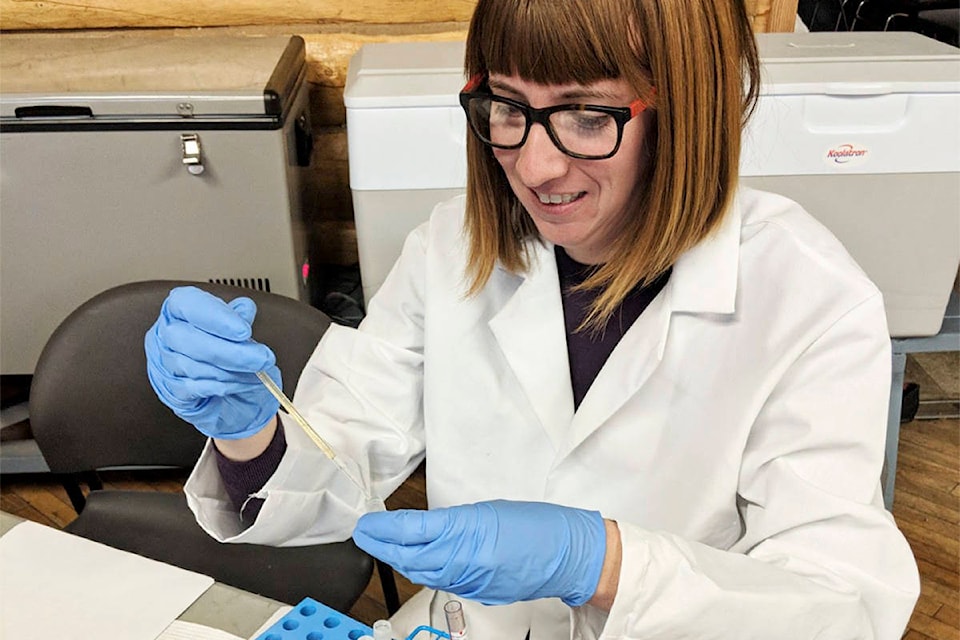Numerous residents of Old Crow turned out the week of Feb. 4 to participate in a biomonitoring study looking at potential contaminant accumulation linked to a traditional diet.
The Vuntut Gwitchin First Nation (VGFN)-led study is geared at investigating “community concerns about the exposure to contaminant levels in traditional food,” the First Nation said via press release. The project was a collaboration between VGFN, a research team from the University of Waterloo and local researcher Mary Gamberg.
As of the morning of Feb.7, 50 people – from those as young as twelve to elders – participated in the testing, which involved taking blood, hair and urine samples, said VGFN executive director William Josie. The project was hoping for a sample size of around 70 people by the time it wrapped up that evening.
A sample size of 70 people is 28 per cent of Old Crow’s population.
The project is looking for a variety of contaminants, including lead, mercury and pesticides, as well as levels of healthy fats, such as omega-three fatty acids, and essential trace elements, said Josie. It builds on work the community has done in the past, including a February 2018 dietary survey which showed the majority of people in Old Crow were eating large amounts of traditional foods, such as caribou, moose, fish and wild berries.
An earlier 2014 wildlife monitoring study conducted in the area found high mercury levels specifically in fish, Josie said, especially long-lived predatory fish like jackfish, as well as in inconnu and whitefish.
The Porcupine Caribou Management Board (PCMB) has also been conducting studies since the ‘90s on contaminants in the flesh of animals from that herd, said Gamberg. Caribou in particular can accumulate perfluorinated alkylated substances (PFAS), which are toxic persistent organic pollutants (POPs) often found in commercial products like firefighting foams, stain removers and paints.
These chemicals persist in the atmosphere and re-enter the environment through rain or atmospheric deposition and are in turn picked up by lichen, which act like “little sponges,” Gamberg said. The caribou eat the lichen and absorb the PFAS, which can further accumulate in apex predators feeding on them, including humans.
While present in wildlife, Gamberg said the levels of PFAS and other contaminants are there at “very very low levels.” She hypothesized that the results of the study will find levels are also low in humans, below what Health Canada has determined to be dangerous to one’s health.
By contrast, similar studies conducted on people in Arctic communities in Nunavut and the Northwest Territories have found populations with much higher levels of contaminants. The traditional diet in those regions is heavy in marine mammals, which bio-accumulate toxins in their fat at a much higher rate than the caribou the Vuntut Gwitchin rely on as a staple of their diets, she said.
Gamberg said results won’t be determined until the samples are analyzed. When that happens each individual will receive a confidential report.
The group data will eventually be presented at a community meeting, Josie said.
‘“People are, just like me, waiting on their results,” he said.
“What we’re doing is developing a baseline data set for where my people stand in the contaminants they carry.”
Josie said the project has been well-received by the community, and that VGFN places importance and finds value in these sorts of studies. VGFN worked very closely with the Outside team and with Gamberg, and were heavily involved in the methodology behind the project, he said.
The project was funded by the Northern Contaminants Program (NCP). Gamberg said it is hoped that the project will act as a pilot for similar work in other Yukon communities.
People with questions about the project are invited to call Josie at (867) 966-3261 ext. 257.
Contact Lori Fox at lori.fox@yukon-news.com
